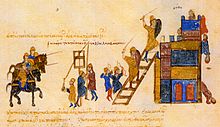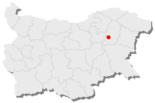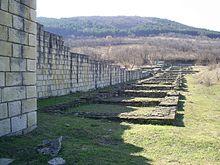Veliki Preslaw
| Veliky Preslav (Велики Преслав) | |||
|
|||
| Basic data | |||
|---|---|---|---|
| State : |
|
||
| Oblast : | Shumen | ||
| Residents : | 7275 (December 31, 2016) | ||
| Coordinates : | 43 ° 10 ' N , 26 ° 49' E | ||
| Height : | 92 m | ||
| Postal code : | 9850 | ||
| Telephone code : | (+359) 0538 | ||
| License plate : | H | ||
| Administration (as of 2007) | |||
| Mayor : | Dimo Bodurow | ||
| Ruling party : | GERB | ||
| Website : | www.velikipreslav.bg | ||
Veliki Preslav [ vɛˈliki prɛsˈɫaf ] (common transliteration Veliki Preslav , Bulgarian Велики Преслав ) is a city in eastern Bulgaria , in the Shumen Oblast , not far from Shumen . It is the third largest city in the oblast after Shumen and Novi Pasar . Veliki Preslaw is the administrative center of the municipality of the same name. The city is one of the 100 national tourist objects in Bulgaria.
geography
Veliki Preslaw is located in the central part of northeast Bulgaria, in the transition from the Ludogorie level to the foothills of the Balkans . The Ludogorie region lies in the Danube Plain, which is characterized by its typical flat or slightly hilly appearance.
The Patlejna (Патлейна) and Dervisha (Дервиша) nature reserves are located near the town of Veliky Preslav. There you can observe, among other things, the knot flowers , which are unique for northern Bulgaria .
Almost 30% of the total area of the municipality of Veliky Preslav is occupied by deciduous and coniferous forests .
structure
City structure
The city is divided into two districts, Center and Kirkowo.
Community structure
The municipality of Veliky Preslav (bulg. Община Велики Преслав) includes 12 other villages in addition to the city of Veliky Preslav.
population
The Bulgarians make up the majority of the population in the municipality with 65%. Beside her there are also a Turkish minority who with their 24% is one of the largest in the country (national average 9%) and a minority of the Sinti and Roma (approx. 8.4%). A small number (less than 1%) of Russians , Wallachians and Armenians also live in the community . 19% of the community population are children under 18 years of age.
Surname
Until 1878, the end of the Ottoman rule over Bulgaria, the city bore the Turkish name Eski Stamboluk (Old Istanbul from eski = old) in addition to the Bulgarian . Preslaw has been a town since 1883 and has been called Veliki Preslaw since 1993.
history
The today rather insignificant small town Veliki Preslaw was under the name Preslaw from 893 to approx. 972 the capital of the first Bulgarian Empire , which dominated the European southeast in the early Middle Ages. The first indications of a settlement in the city come from Thracians from the 13th to 14th centuries. Century BC Chr.
The city goes back to a Slavic settlement . Around 678, the Slavic tribes living in Moesia allied themselves with the original Bulgarians and founded the first Bulgarian empire as the successor to the Greater Bulgarian Empire. Preslaw developed into a center of strategic importance with a permanent military presence that served as the hub of the ancient Roman roads from west to east and north to south. During this time, however, the city remained Slavic.
The Bulgarian rulers Khan Krum and his son Omurtag fortified and expanded Preslav in order to secure the Warbizapass in the Balkan Mountains, over which the Byzantines invaded Bulgaria several times (see Battle of the Warbiza Pass ). Preslaw became the seat of the Ichirgu-Boil , administrator of the capital and commander of the capital's garrison .
In 893, after an uprising by the old elites against the Christianization of the country in the nearby town of Pliska , the capital of the Bulgarian Empire was moved by Tsar Simeon the Great to Preslav. As the capital of an empire that encompassed the largest part of the Balkan Peninsula, the city experienced its heyday, in which it developed in the Bulgarian empire next to Ohrid (→ School of Ohrid ) into a center of the Old Church Slavonic writing culture (see also School of Preslaw ), but never reached the size of the old capital. In addition to the large-scale ruler's palaces with their foundations , a patriarchal palace was built in 927 when Preslav became the seat of the patriarch of the independent Bulgarian Orthodox Church . When they were built, glass and gold were used to decorate the ornaments of the marble columns and capitals in addition to color. The walls, floors and ceilings were decorated with mosaics based on the Byzantine model.
At the court of the Bulgarian tsars in Preslaw, according to today's view, the Cyrillic alphabet was created around the middle of the 10th century . An authorship of the Slav apostles Cyril and Method , who lived a century earlier, can therefore be excluded. The expansion of the city was continued after the death of Tsar Simeon by his son Tsar Petar I , who negotiated a 50-year peace with Byzantium.

Around 970, after the occupation by the Kiev prince Svyatoslaw I and the Varangians , the city was sacked and became the capital of the Kievan Rus . The capital of the Bulgarian Empire was moved to the western part of the state, to Ohrid. In 972, however, Preslaw was captured and burned down by the army of the Byzantine emperor Johannes I. Tzimiskes . Most of the Simeon library, however, was moved to Constantinople.
In the Second Bulgarian Empire (1189-1396) the city was used again as a military camp with strategic importance. However, Veliko Tarnowo , located in the middle of the Balkan Mountains, was chosen as the new capital . In the Tatar storm around 1270, the last inhabitants left the fortress and founded the new town of Veliky Preslav two kilometers north.
The fortress was finally destroyed in 1388 by the advancing Ottomans . The nearby new city was also destroyed. The city found it difficult to recover from it. The re-excavated ruins of the city are located in an archaeological park near the present city.
In 1808 the church of “St. Apostles Peter and Paulis “( Bulgar . Св. Апостоли Петър и Павел ). In 1874 the Tschitalischte (culture house) "Razwitie" (Bulgarian Развитие , to German development) was founded, which today houses several singing, dancing and play clubs as well as the city library. Four years later, Preslaw was liberated from Ottoman-Turkish rule in the course of the "Russo-Turkish War of Liberation" of 1877/78.
Since 2004, the city has given its name to Preslav Crag , a mountain on Livingston Island in Antarctica.
Attractions
In addition to the ruins of the medieval Bulgarian capital, which are summarized in the historical-archaeological reserve "Veliki Preslav", there is an art gallery and several churches from the time of the Bulgarian National Revival .
The Archaeological Museum
The Archaeological Museum is located in the area of the former fortress. The museum houses more than 35,000 finds from the nearby 500- hectare capital area and was built in 1904. Several treasures are exhibited here, including parts of the famous Preslaw gold treasure from the middle of the 10th century. Preslav pottery, typical of the art of the First Bulgarian Empire, and one of the largest collections of Byzantine state seals can also be seen here.
Monastery of Saint Panteleimon
About 6 km south of today's city, above the old fortress, there is the monastery of St. Panteleimon (Bulgarian Свети Пантелеймон) in the Patlejna area. The large-scale monastery complex was built in the 9th century and destroyed in the 12th century. The ruins of the Tsar's monastery are uncovered by archaeologists. Historians suspect that Preslaw's school, famous in the Middle Ages, developed the Cyrillic alphabet , among other things . Simeon the Great is said to have withdrawn here after his training in Byzantium and pursued literary activities before he was elected ruler of Bulgaria in the Council of Pliska in 893 .
His father Knjaz Boris is said to have entered here when he resigned from his rule. Knjaz Boris died in the monastery on May 2nd, 907. The famous ceramic icon of St. Theodor Stratelates was found here during excavations .
Regular events
May 24th is the public holiday of Veliky Preslav. On June 28th there is a folklore and folk festival.
literature
- Gerhard Ecker: Bulgaria. Art monuments from four millennia from the Thracians to the present , DuMont Buchverlag, Cologne, 1984, p. 65, p. 107-109
- Harald Heppner : Capitals between the Save, Bosporus and Dnieper: history, function, national symbolism. , Böhlau Verlag, Vienna-Cologne-Weimar, 1998
Web links
- Website of the Historical and Archaeological Museum in Veliki Preslav
- Cultural history of Bulgaria: Veliki Preslaw ( Memento from June 7, 2011 in the Internet Archive )
- The Round Church of Preslaw
Individual evidence
- ↑ Население (population) on the website of the city of Veliky Preslav ( Memento of May 5, 2009 in the Internet Archive )
- ^ Raymond Detrez: Historical dictionary of Bulgaria , Scarecrow Pr., 1997, ISBN 0-8108-3177-5 , p. 173
- ↑ Cf. Nicolina Trunte: словѣньскъи ѩзꙑкъ: A practical textbook of Church Slavonic in 30 lessons, Vol. 1, 4th edition, Munich 1994, chap. 1.9; Pp. 16-19 .; Hans-Dieter Döpmann : Church in Bulgaria from its beginnings to the present , Munich, Biblion Verlag, 2006; Gerhard Podskalsky : Theological literature of the Middle Ages in Bulgaria and Serbia 815-1459 , Munich, Beck, 2000





